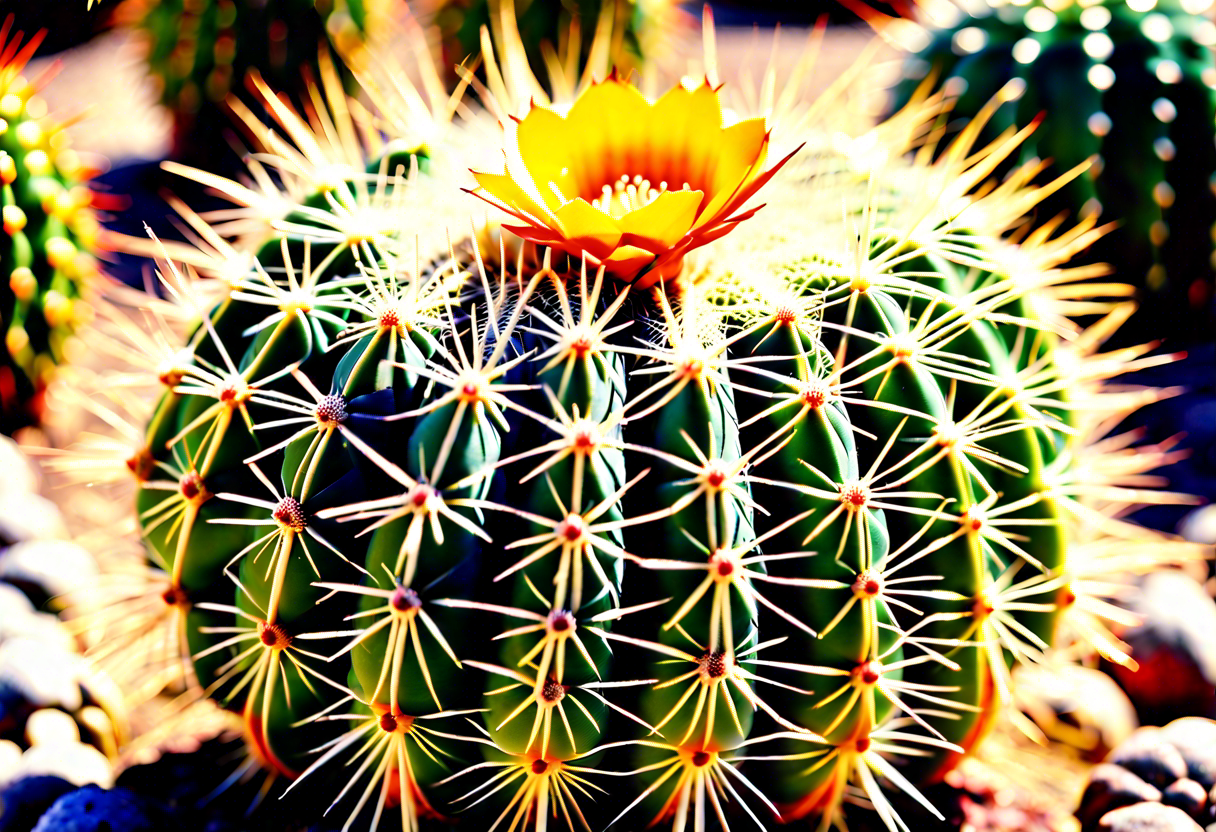Importance of Barrel Cactus (Ferocactus) in Desert Ecosystems
Barrel Cactus, scientifically known as Ferocactus, plays a vital role in sustaining desert ecosystems worldwide. These iconic succulents are characterized by their barrel-shaped appearance and are endemic to arid regions of the Americas. Their significance within the ecosystem extends beyond their striking aesthetic appeal to encompass various ecological functions.
One of the primary roles of Barrel Cactus in desert ecosystems is its ability to store water efficiently. The succulent nature of the cactus allows it to retain large quantities of water within its thick, fleshy stems. During periods of extended drought, this stored water serves as a critical resource for various desert animals, including birds and rodents.
In addition to being a valuable water source, Barrel Cactus also provides shelter and nesting sites for wildlife. The spiny exterior of the cactus acts as a natural deterrent, protecting small animals from predators and offering a safe refuge from the harsh desert environment. Birds, in particular, are known to nest among the spines of Barrel Cactus, taking advantage of the protection it offers.
Furthermore, Barrel Cactus plays a crucial role in soil stabilization within desert ecosystems. The extensive root system of the cactus helps anchor the soil, preventing erosion caused by wind and water. By maintaining the integrity of the soil structure, Barrel Cactus contributes to the overall health of the ecosystem and supports the growth of other plant species in the area.
The presence of Barrel Cactus in desert ecosystems is essential for maintaining biodiversity and ecological balance. As a keystone species, the cactus provides valuable resources, habitat, and stability that support the survival of various desert organisms. Preserving the populations of Barrel Cactus is not only crucial for the cactus itself but also for the entire desert ecosystem that relies on its presence.
For more information on the importance of Barrel Cactus in desert ecosystems, you can visit The Arizona-Sonora Desert Museum.
Growth and Maintenance Tips for Barrel Cactus (Ferocactus) in Home Gardens
Barrel cacti, commonly known as Ferocactus, are popular additions to home gardens due to their unique appearance and low-maintenance requirements. These cacti thrive in arid climates and can be cultivated successfully with the right care. To ensure the healthy growth of your Barrel Cactus, consider the following tips:
1. Sunlight: Barrel Cacti require plenty of sunlight to thrive. Choose a sunny spot in your garden that receives direct sunlight for at least 6-8 hours a day. Insufficient sunlight can result in leggy growth and poor flowering.
2. Soil: Well-draining soil is crucial for Barrel Cacti. Use a cactus mix or amend regular potting soil with sand or perlite to improve drainage. Avoid overwatering, as soggy soil can lead to root rot.
3. Watering: Barrel Cacti are drought-tolerant plants that require minimal watering. Allow the soil to dry out completely between waterings. During the growing season (spring and summer), water sparingly, and reduce watering in the winter months to mimic their natural habitat.
4. Potting: If planting Barrel Cacti in pots, choose containers with drainage holes to prevent waterlogging. Repot your cactus every 2-3 years to refresh the soil and provide ample space for growth.
5. Fertilization: Barrel Cacti are not heavy feeders. Fertilize sparingly with a diluted cactus fertilizer during the growing season to promote healthy growth. Avoid over-fertilizing, as this can damage the roots.
6. Protection: In colder climates, protect your Barrel Cactus from frost and freezing temperatures. Move potted cacti indoors or provide frost protection for garden-planted specimens during winter.
7. Pests and Diseases: Keep an eye out for common cactus pests such as mealybugs and spider mites. Remove pests by spraying cacti with water or using neem oil. Ensure good air circulation to prevent fungal diseases.
By following these growth and maintenance tips, you can enjoy healthy and vibrant Barrel Cacti in your home garden. For more information on caring for cacti, visit CactusGuide.
Unique Characteristics and Adaptations of Barrel Cactus (Ferocactus)
Barrel Cactus, scientifically known as Ferocactus, is a fascinating desert plant that showcases a variety of unique characteristics and adaptations to thrive in arid environments. One of the most distinctive features of the Barrel Cactus is its cylindrical shape, resembling a barrel or drum, hence its common name. This shape allows the cactus to store water efficiently, enabling it to survive extended periods of drought in its native desert habitats.
Another remarkable adaptation of the Barrel Cactus is its spines, which serve multiple functions. These sharp spines help protect the plant from herbivores by deterring them from feeding on its succulent tissues. Additionally, the spines provide shade to the cactus by creating a microclimate that reduces water loss through evaporation. This adaptation is essential for the cactus to conserve water, especially during hot and dry conditions.
Barrel Cacti are also known for their beautiful flowers that bloom atop the plant’s body. These vibrant blooms attract pollinators such as bees, butterflies, and birds, facilitating the cactus’s reproduction process. The flowers of the Barrel Cactus come in various colors, including shades of red, orange, and yellow, adding a striking visual appeal to the desert landscape.
Furthermore, Barrel Cacti exhibit an impressive ability to adapt to extreme temperatures and sunlight exposure. Their thick, waxy skin helps reduce water loss through transpiration and provides insulation against intense heat. This adaptation allows the cactus to thrive in regions with high temperatures and limited rainfall, making it a valuable species in xeriscaping and drought-tolerant gardening.
In addition to their unique physical characteristics, Barrel Cacti have a slow growth rate, with some species taking several decades to reach full maturity. This slow growth is a survival strategy that allows the cactus to allocate resources efficiently and withstand harsh environmental conditions over an extended period.
The Barrel Cactus (Ferocactus) stands out as a remarkable example of nature’s ability to adapt and thrive in challenging desert environments. Its distinctive characteristics, from its cylindrical shape and spines to its colorful flowers and slow growth rate, make it a fascinating plant to study and appreciate in both natural habitats and cultivated gardens.
Medicinal and Cultural Uses of Barrel Cactus (Ferocactus) by Indigenous Peoples
Barrel Cactus, scientifically known as Ferocactus, holds significant cultural and medicinal value among various indigenous tribes across the arid regions where it thrives. Historically, indigenous peoples have utilized different parts of the Barrel Cactus for a wide array of purposes, ranging from traditional medicine to spiritual practices.
One of the primary traditional uses of the Barrel Cactus by indigenous groups is for medicinal purposes. The pulp found inside the cactus has been used to treat various ailments such as skin infections, wounds, and digestive issues. It is believed that the mucilaginous sap within the cactus has soothing and healing properties when applied topically. Additionally, the high water content of the Barrel Cactus has been a vital source of hydration for tribes living in desert environments where water sources are scarce.
In addition to its medicinal uses, the Barrel Cactus holds cultural significance among indigenous communities. The cactus is often incorporated into traditional ceremonies and rituals, symbolizing endurance, resilience, and the ability to thrive in harsh conditions. Various tribes have stories and legends that revolve around the Barrel Cactus, further solidifying its importance in their cultural heritage.
Moreover, the spines of the Barrel Cactus have been repurposed by indigenous peoples for crafting tools, baskets, and even as needles for intricate artwork. The durable and sharp spines serve a practical purpose in daily life and artistic expression, showcasing the resourcefulness of these communities in utilizing every part of the cactus sustainably.
The Barrel Cactus (Ferocactus) plays a crucial role in the medicinal practices and cultural traditions of indigenous peoples in arid regions. The respect and reverence for this resilient plant have been passed down through generations, illustrating the deep connection between people and the natural world in these environments.
To delve deeper into the medicinal and cultural significance of Barrel Cactus among indigenous tribes, you can visit relatedwebsite.com for additional insights and information.
Whether it’s providing healing remedies or serving as a symbol of endurance, the Barrel Cactus continues to hold a special place in the hearts and traditions of indigenous communities across the desert landscapes where it flourishes.
Conservation Efforts and Threats Facing Barrel Cactus (Ferocactus) in the Wild
Barrel cacti, scientifically known as Ferocactus, play a crucial role in maintaining the delicate balance of desert ecosystems. These iconic plants are well-adapted to thrive in arid environments, serving as food and shelter for various desert animals. Despite their resilience, barrel cacti face several conservation challenges that threaten their existence in the wild.
One of the primary threats to barrel cacti is habitat loss due to urbanization, agriculture, and land development. As human populations expand into desert areas, the natural habitats of these cacti are rapidly disappearing. This loss of habitat not only affects the barrel cacti themselves but also endangers the diverse range of wildlife that depend on them for survival.
Furthermore, illegal collection and poaching of barrel cacti pose a significant risk to their populations. These plants are often sought after for ornamental purposes or for the illegal plant trade. Unregulated harvesting can have devastating effects on barrel cactus populations, leading to a decline in their numbers and genetic diversity.
Climate change is another pressing concern for the conservation of barrel cacti. As temperatures rise and rainfall patterns shift, desert ecosystems are experiencing increased stress. Barrel cacti, with their specialized water storage abilities, are particularly vulnerable to the unpredictable effects of climate change. Prolonged droughts, extreme heat, and severe weather events can all impact the health and survival of these iconic desert plants.
To address these conservation challenges, various organizations and conservation groups are working to protect and preserve barrel cactus populations in the wild. Efforts such as habitat restoration, public awareness campaigns, and legal protections aim to safeguard these plants and their ecosystems for future generations to enjoy.
The conservation of barrel cacti is essential for maintaining the biodiversity and ecological balance of desert environments. By raising awareness about the threats facing these iconic plants and taking concrete actions to protect them, we can ensure that barrel cacti continue to thrive in their natural habitats for years to come.
For more information on the conservation of barrel cacti and desert ecosystems, visit Desert Museum.
Conclusion
Barrel Cactus, scientifically known as Ferocactus, holds immense importance in desert ecosystems due to its unique characteristics and vital role in supporting biodiversity. These resilient plants serve as a source of food and water for various desert animals, helping to maintain the delicate balance of the ecosystem. Additionally, their ability to thrive in arid conditions makes them crucial for stabilizing soil and preventing erosion in desert landscapes.
For those looking to incorporate Barrel Cactus into their home gardens, there are several key growth and maintenance tips to keep in mind. These plants require well-draining soil, ample sunlight, and minimal water to flourish. By mimicking their natural habitat, gardeners can ensure the health and longevity of their Barrel Cactus. Regular monitoring for pests and diseases is also essential to prevent any potential issues that may arise.
One of the most intriguing aspects of Barrel Cactus is their unique characteristics and adaptations that have allowed them to survive in harsh desert environments. From their barrel-shaped bodies that store water to their spines that provide protection from predators and reduce water loss, these cacti have evolved remarkable features over time. Their ability to withstand extreme temperatures and periods of drought makes them true survivors of the desert.
Indigenous peoples have long recognized the medicinal and cultural significance of Barrel Cactus. Some tribes use the plant for its healing properties, employing it to treat various ailments such as fevers, infections, and digestive issues. Additionally, Barrel Cactus plays a vital role in traditional ceremonies and practices, symbolizing resilience, endurance, and adaptation to challenging environments.
Despite their resilience, Barrel Cactus face threats in the wild due to habitat destruction, illegal harvesting, and climate change. Conservation efforts are underway to protect these iconic plants and ensure their survival for future generations. Organizations are working to raise awareness about the importance of preserving Barrel Cactus and implementing measures to safeguard their natural habitats.
Barrel Cactus (Ferocactus) is a fascinating plant with a rich history of ecological, cultural, and medicinal significance. Its role in desert ecosystems, unique characteristics, and conservation status highlight the need to appreciate and protect these remarkable plants. By understanding and valuing the importance of Barrel Cactus, we can contribute to their preservation and continued existence in the wild.


